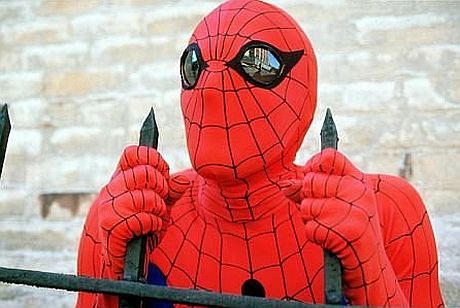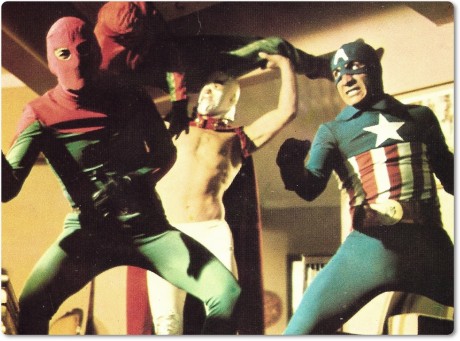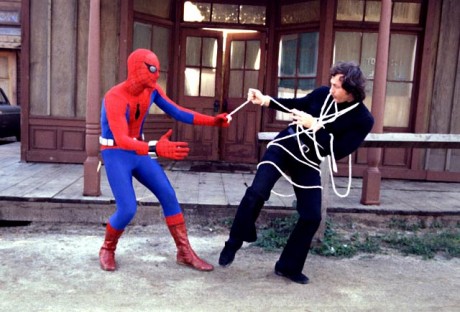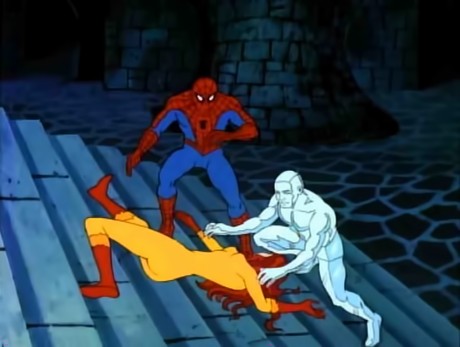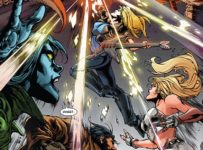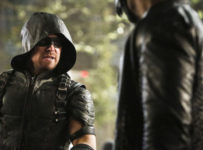The Amazing Spider-man swings into cinemas this week, and as most people know, it certainly isn’t the first time our friendly neighbourhood wall-crawler has slapped on the spandex and spun his way into our hearts. We take a look back at some of the highlights, and incredible lowlights, of over fifty years on our screens of all sizes.
1960s
Spider-man (1967 – 1970)
Spider-man first appeared in print in the August 1962 edition of Amazing Fantasy #15, and is worth an estimated $140,000 US today, and probably more at auction. Of course, in those days it was just another best-selling character, that was quickly parlayed into The Amazing Spider-man #1 in 1963, a book that has been in continuous publication since. TV’s Spider-man (1967-1970) was the first animated adaptation of the popular comic. After producers Grantray-Lawrence Animation went bankrupt, Ralph Bakshi took over and became known for his budget-saving animation. One episode completely reused background animation, characters, and even a storyline from an episode of Canada’s Rocket Robin Hood.
The series ran for a fairly impressive 52 episodes, and the complete package was released on DVD as Spider-Man – The ’67 Collection (6 Volume Animated Set) back in 2004. Paul Soles provides the voice for Peter Parker/Spider-man, and a number of comic book regulars turned up in the show.
For many, this was their introduction to Spider-man, and the show hasn’t aged well. Indeed, it was the subject of a popular Internet caption meme for some years. It is probably best remembered for its theme song, composed by composed by Academy Award winner Paul Francis Webster and Robert “Bob” Harris, that taught us “action is his reward”. Note the misspelling of “Jewelry”.
Donald F. Glut’s Fan Film (1969)
For the bold, there’s also this 1969 fan film, which is not only the first documented fan film for Spidey, but his first (unofficial) live action appearance as well. Donald F. Glut wrote, amongst other things, the novelisation for The Empire Strikes Back, along with episodes of the two Spider-man animated series of the 1980s (discussed below) and He-Man: Masters of the Universe. More recently he’s been behind erotic films Mummy’s Kiss and Countess Dracula’s Orgy of Blood! Production values aside, it’s not bad and makes interesting use of low-budget web-slinging!
1970s
3 Dev Adam (1973)
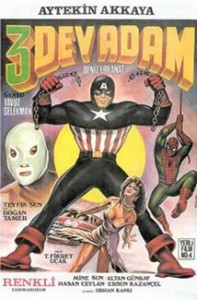 It was the best of times, it was the worst of times for Spidey in the ’70s. At the dawn of the decade, it would be another eight years before Nicolas Hammond would hand in his Sound of Music lederhosen and trade them for red and blue spandex. To fill in the void, Turkey’s Tual Film employed the talents of T. Fikret Uçak for the forgotten “masterpiece” 3 Dev Adam (aka Captain America and Santo vs. Spider-Man). Here Spidey is a bit of a dick, leading a criminal organisation. Only Captain America (Aytekin Akkaya) and Mexican wrestler El Santo (actually portrayed by a Turkish actor) have any chance of stopping him. Naturally, this is a completely unauthorised film and, despite a pretty awesome poster, features a green suited Spider-man with black gloves and a pot belly, depicted as a fairly psychotic murderer who raises himself from the dead several times! Investigate this one at your own peril.
It was the best of times, it was the worst of times for Spidey in the ’70s. At the dawn of the decade, it would be another eight years before Nicolas Hammond would hand in his Sound of Music lederhosen and trade them for red and blue spandex. To fill in the void, Turkey’s Tual Film employed the talents of T. Fikret Uçak for the forgotten “masterpiece” 3 Dev Adam (aka Captain America and Santo vs. Spider-Man). Here Spidey is a bit of a dick, leading a criminal organisation. Only Captain America (Aytekin Akkaya) and Mexican wrestler El Santo (actually portrayed by a Turkish actor) have any chance of stopping him. Naturally, this is a completely unauthorised film and, despite a pretty awesome poster, features a green suited Spider-man with black gloves and a pot belly, depicted as a fairly psychotic murderer who raises himself from the dead several times! Investigate this one at your own peril.
Spidey Super Stories (1974 – 1977)
Outside of the comics, and Turkish spin-offs, Spider-man could be seen in the PBS educational show The Electric Company in a series of live action-animation mixed shorts called Spidey Super Stories (1974 – 1977), with a costumed Spider-man (puppeteer and dancer Danny Seagren). The silent Spider-man often reacted to a narrator via speech bubbles, meaning he was minus his trademark quips, and faced off against a series of villains such as The Spoiler, Dr. Fly or the nefarious Can Crusher. Educational in nature, the series of shorts is also notable for several appearances by Morgan Freeman, who not only served as narrator but turned up as Easy Reader and even Count Dracula, terrorising a movie theatre. It’s theme song is less well-known:
Spider-Man, where are you coming from?
Spider-Man, nobody knows who you are!
Spider-Man, you’ve got that Spidey touch
Spider-Man, you are a web-slinging star!
The Amazing Spider-man (1977-1979)
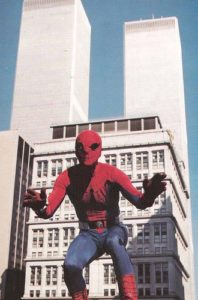 Spider-man finally appeared in live action form, complete with his own voice and a real actor playing Peter Parker (Nicolas Hammond) in the short-lived series (14 episodes) The Amazing Spider-man. The 1977 pilot movie was actually released theatrically overseas, but for most in the US, it could be found on CBS, who were fast developing a name as the superhero network. Indeed, with The Incredible Hulk (1977 – 1982), a Captain America TV movie (1979), Dr. Strange TV movie (1978) and Wonder Woman (1976 – 1979), which moved to CBS from ABC in its final two seasons, much of the reason the show was allegedly dropped was not due to bad ratings, but the cost of running superhero shows. Both Spidey and Wonder Woman got the shaft in the same season, despite Spider-man’s top 20 performance in its debut season.
Spider-man finally appeared in live action form, complete with his own voice and a real actor playing Peter Parker (Nicolas Hammond) in the short-lived series (14 episodes) The Amazing Spider-man. The 1977 pilot movie was actually released theatrically overseas, but for most in the US, it could be found on CBS, who were fast developing a name as the superhero network. Indeed, with The Incredible Hulk (1977 – 1982), a Captain America TV movie (1979), Dr. Strange TV movie (1978) and Wonder Woman (1976 – 1979), which moved to CBS from ABC in its final two seasons, much of the reason the show was allegedly dropped was not due to bad ratings, but the cost of running superhero shows. Both Spidey and Wonder Woman got the shaft in the same season, despite Spider-man’s top 20 performance in its debut season.
The show took a number of liberties with the source material, and lack any real super villains. Spidey also rocked a white utility belt, and as can be seen in the picture below, web fluid was decidedly ropey. Additionally, Los Angeles served as a stand-in for New York City. Yet there was still a lot of love for the series, and for many this may be the “true” Spider-man that they remember.
Along with the pilot, the second and third episodes of the series, the two-part “Deadly Dust”, was released internationally in cinemas as Spider-Man Strikes Back (1978). The final episode, “The Chinese Web”, was a two-hour special released theatrically internationally asThe Dragon’s Challenge (1979) These films, and the episodes themselves, are still not available on DVD or any official digital format.
Spider-Man (スパイダーマン, 1978 – 1979)
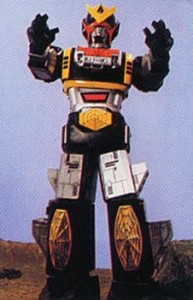 Spider-man’s live-action adventures didn’t just span the US, but the East as well. Also known as Japanese Spider-man, about the only thing that motorcycle racer Takuya Yamashiro (Shinji Todō) has in common with Peter Parker is the costume. Takuya sees the spaceship “Marveller” from the planet “Spider” fall to Earth, and his father is killed while investigating. Raising the attention of Professor Monster and his evil Iron Cross Army, Takuya gains his powers from the last surviving warrior from Planet Spider, much like Green Lantern’s origin story. Japanese Spider-man must fight the nefarious Professor Monster, with a bracelet that gives him his suit, web-lines and can summon a ship that transforms into a giant robot named Leopardon. This really happened.
Spider-man’s live-action adventures didn’t just span the US, but the East as well. Also known as Japanese Spider-man, about the only thing that motorcycle racer Takuya Yamashiro (Shinji Todō) has in common with Peter Parker is the costume. Takuya sees the spaceship “Marveller” from the planet “Spider” fall to Earth, and his father is killed while investigating. Raising the attention of Professor Monster and his evil Iron Cross Army, Takuya gains his powers from the last surviving warrior from Planet Spider, much like Green Lantern’s origin story. Japanese Spider-man must fight the nefarious Professor Monster, with a bracelet that gives him his suit, web-lines and can summon a ship that transforms into a giant robot named Leopardon. This really happened.
Running for 41 episodes, Toei’s Spider-man actually influenced the development of later Super Sentai series that would ultimately lead to the likes of Power Rangers, footage from which became the basis of a popular US show. The circle was complete. The good folks at Marvel have uploaded the entire series, with English subtitles, to their site.
Spider-Woman (1979 – 1980)
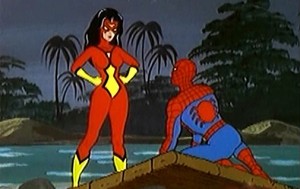 When Jessica Drew (aka Spider-Woman) got her own show in the late 1970s, she largely carried the series by herself. While her animated counterpart lacked some of the super strength of her comic book origins, she was a bold new Spider-Woman for an age where female superheroes were starting to come into their own. Of course, it only ran for 16 episodes.
When Jessica Drew (aka Spider-Woman) got her own show in the late 1970s, she largely carried the series by herself. While her animated counterpart lacked some of the super strength of her comic book origins, she was a bold new Spider-Woman for an age where female superheroes were starting to come into their own. Of course, it only ran for 16 episodes.
Spider-man made two appearances in the series, in the pilot episode “Pyramids of Terror” and “The Congo Spider”. He was played by Paul Soles, the same gent who gave the 1960s animated Spider-man his voice. In many ways, Spider-Woman can be seen as the direct successor to this legacy, or at least an official spin-off.
1980s
Spider-Man (1981 – 1982)
The Decade of Shame began for Spider-man with not one, but two Spider-man animated series. The first of these was a syndicated show simply titled Spider-Man, from DePatie-Freleng Enterprises who had previously produced Spider-Woman. Despite being quite faithful to the comics, the series was never as popular as its contemporary Spider-man and His Amazing Friends (below).
Running for 26 episodes, the series is notable for updating Peter Parker’s look to be less conservative 1960s suit and more casual early 80s lad about town. According to the Wikipedia entry, “Due to network constraints and demands from parents, characters such as Spider-Man were not allowed to make a fist to strike an opponent, but the show’s creators managed to conceal these issues with a focus on action and relatively fluid animation”.
The series is available in the UK on DVD under the odd title of Spider-Man 5000.
Spider-Man and His Amazing Friends (1981 – 1983)
Starting on NBC on the same day as Spider-Man (12 September 1981), the three “seasons” of the Marvel Productions series ran for 24 episodes. The premise saw Peter Parker (this time voiced by Dan Gilvezan, also known for Transformers‘ Bumblebee!) attend college with Bobby Drake (Iceman), and Angelica Jones (Firestar), and all live together with Aunt May and a pet Lhasa Apso. A slight departure from the comics, but it did manage to include a plethora of Marvel characters including the Hulk, Mysterio, Red Skull (all voiced by Peter “Optimus Prime” Cullen), Captain America and a number of the X-Men.
In the second season, the show was aired with a new Hulk series as The Incredible Hulk and the Amazing Spider-Man and was simply three origin stories for each of the main characters. From the third season, it underwent another title change to The Amazing Spider-Man and the Incredible Hulk. Along with Spider-Man, the show would form part of the 90-minute Marvel Action Universe, which collected various animated series of the time along with animated adaptations of RoboCop and Dino-Riders.
Stay tuned, true believers…
Attempts were made to combine The Incredible Hulk and The Amazing Spider-man live-action shows around 1984, with Nicolas Hammond set to reprise his role as Peter Parker/Spider-man. Spider-man would not be seen again in an official live action form until 2002, and it would be another decade before the superior Spider-Man animated series (1994 – 1998) would hit the air.

